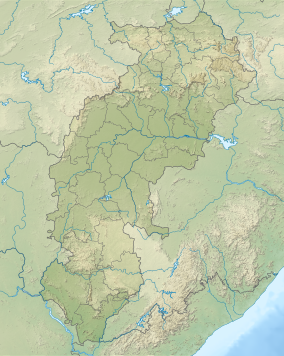| Guru Ghasidas - Tamor Pingla Tiger Reserve | |
|---|---|
  | |
| Location | Spread across 4 Districts - Manendragarh-Chirmiri-Bharatpur (MCB), Korea, Surajpur, and Balrampur of Chhattisgarh |
| Nearest city | Baikunthpur |
| Coordinates | 23°36′7″N 82°28′19″E / 23.60194°N 82.47194°E / 23.60194; 82.47194 |
| Area | 2,829.387 km (1,092.432 sq mi) |
| Designation | Tiger Reserve |
| Designated | 2024 |
Guru Ghasidas-Tamor Pingla Tiger Reserve in Chhattisgarh is the 56th Tiger Reserve of India announced in November 2024 which is situated across the districts of Manendragarh-Chirmiri-Bharatpur (MCB), Korea, Surajpur, and Balrampur. This tiger reserve covers a total area of 2,829.38 square kilometres (1,092.43 sq mi), including a core or critical tiger habitat of 2,049.2 square kilometres (791.2 sq mi), which consists of the Guru Ghasidas National Park and the Tamor Pingla Wildlife Sanctuary, along with a buffer zone of 780.15 square kilometres (301.22 sq mi). This designation positions it as the third largest tiger reserve in the nation, following the Nagarjunsagar-Srisailam Tiger Reserve in Andhra Pradesh and the Manas Tiger Reserve in Assam.
The Guru Ghasidas-Tamor Pingla Tiger Reserve received final approval for its notification from the National Tiger Conservation Authority in October 2021.
Landscape
The core area of the tiger reserve is 2,049.23 km (791.21 sq mi), including 1,440.70 km (556.26 sq mi) of Guru Ghasidas National Park and 608.52 km (234.95 sq mi) of Tamor Pingla Wildlife Sanctuary. The buffer area is 780.15 km (301.22 sq mi). The total area of the reserve is 2,829.38 km (1,092.43 sq mi). In accordance with the landscape approach to conservation proposed in India’s National Wildlife Plan, this tiger reserve is adjacent to the Sanjay-Dubri Tiger Reserve in Madhya Pradesh, forming a landscape complex that covers nearly 4,500 square kilometres (1,700 sq mi). Furthermore, this tiger reserve is connected to the Bandhavgarh Tiger Reserve to the west and the Palamau Tiger Reserve to the east in Jharkhand.
Situated in the Chhota Nagpur Plateau and extending into the Baghelkhand plateau, the tiger reserve is characterized by its varied landscapes, dense woodlands, and numerous streams and rivers, which create an environment conducive to a rich diversity of fauna and serve as vital habitats for the tiger.
Biodiversity
The Zoological Survey of India has recorded a total of 753 species within the Guru Ghasidas-Tamor Pingla Tiger Reserve, comprising 365 invertebrates and 388 vertebrates. The invertebrate population is predominantly made up of insects, while the vertebrate population features 230 bird species and 55 mammal species, including several that are classified as threatened.
References
- Sikdar, Shubhomoy (7 August 2024). "Chhattisgarh govt. to develop fourth tiger reserve in State". The Hindu. Retrieved 4 December 2024.
- ^ "After decade-long wait, Chhattisgarh to get its 4th tiger reserve". Deccan Herald. Retrieved 4 December 2024.
- "After HC Prod CG Govt Notifies Guru Ghasidas-Tamor Pingla Tiger Reserve". Times of India. 19 November 2024. Retrieved 13 January 2025.
- Choubey, Jitendra (19 November 2024). "India's 56th tiger reserve notified in Chhatisgarh". The New Indian Express. Retrieved 4 December 2024.
- "Everything you need to know about Chhattisgarh's newest tiger reserve". The Indian Express. 23 November 2024. Retrieved 4 December 2024.
- "Can Chhattisgarh recover lost ground in conservation with its fourth tiger reserve?". India Today. 21 November 2024.
| This article needs additional or more specific categories. Please help out by adding categories to it so that it can be listed with similar articles. (December 2024) |